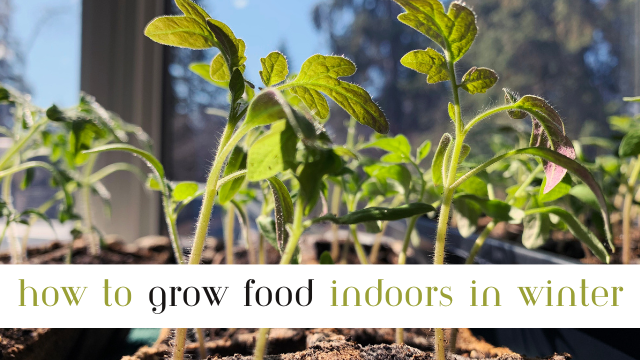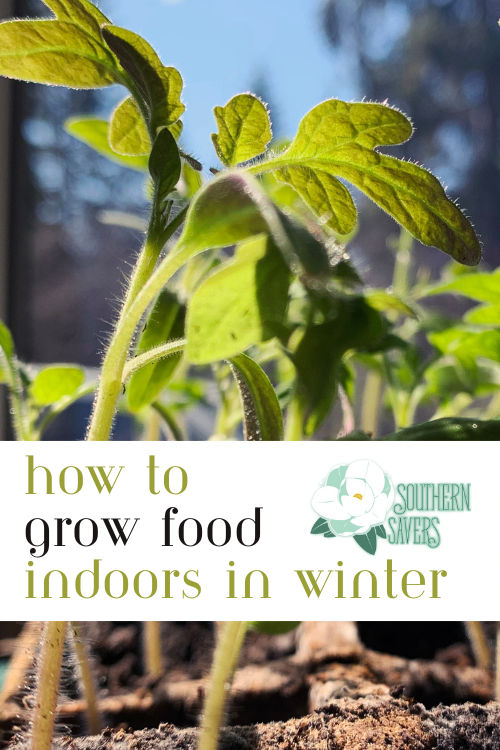This post may contain affiliate links. Read our disclosure here.

I’ve shared a lot about growing vegetables outside, but you can also grow vegetables inside! Growing vegetables indoors during the winter months can be a rewarding way to enjoy fresh produce even when outdoor conditions are harsh. Here are my tips on how to grow vegetables indoors in winter.
If you want to see other gardening posts, check out my top posts on gardening!
How to Grow Food Indoors in Winter
Choose suitable vegetables
Opt for vegetables that are well-suited for indoor growing. Some good choices include lettuce, spinach, kale, radishes, green onions, microgreens, and herbs like basil, parsley, and cilantro. These crops have shorter growth cycles and can thrive in containers.
Find the right location
Select a sunny location for your indoor garden. Vegetables need ample sunlight, so place your containers near a south-facing window that receives at least 6-8 hours of sunlight per day. If natural light is insufficient, consider using grow lights.

Gather containers and soil
Use containers or pots with good drainage to prevent over-watering. Ensure there are saucers to catch excess water. Use a high-quality potting mix specifically formulated for vegetables or herbs.
Start seeds or transplants
You can either start vegetables from seeds or purchase young transplants from a nursery or garden center. If you’re starting from seeds, follow the instructions on the seed packets regarding planting depth and spacing.
Provide adequate water
Water your indoor vegetables carefully. Keep the soil consistently moist but not waterlogged. Use a watering can with a fine nozzle to avoid disturbing the soil surface.

Maintain humidity
Indoor environments can be dry during the winter, which may affect plant health. Increase humidity by misting the plants regularly, placing a tray of water near the containers, or using a humidifier.
Control the temperature
Most vegetables prefer temperatures between 60°F and 70°F. Avoid placing plants near drafts or radiators, as extreme temperature fluctuations can stress them.
Fertilize appropriately
Use a balanced, water-soluble fertilizer designed for vegetables. Follow the package instructions for frequency and application rates. Indoor plants often require less fertilizer than outdoor ones.

Prune and maintain
Regularly prune or pinch back your plants to encourage bushier growth. Remove any dead or yellowing leaves promptly. Keep an eye out for pests and address them promptly with organic pest control methods.
Harvest at the right time
Harvest your vegetables when they reach the desired size and maturity. Most leafy greens can be harvested as soon as they have several leaves, while root crops like radishes can be pulled when they’re the right size.
Rotate and succession plant
To prevent soil depletion and maximize your indoor garden’s productivity, consider rotating your crops and planting new seeds or transplants every few weeks for a continuous harvest.

Pollinate
Some vegetables, like tomatoes and peppers, require pollination to produce fruit. Gently shake the plants or use a small paintbrush to transfer pollen between flowers if you notice poor fruit set.
Remember that while indoor gardening can extend your growing season, it may not yield as much as an outdoor garden. However, it’s an excellent way to enjoy fresh, homegrown produce during the winter months and can be a fun, inexpensive, and educational experience for gardeners of all levels.
Have you ever tried to grow food indoors? Let us know how it went in the comments!



